The Apple iPad 2 Review
by Brian Klug, Anand Lal Shimpi & Vivek Gowri on March 19, 2011 8:01 PM ESTThe GPU: Apple's Gift to Game Developers
The GPU side of the A5 is really what's most exciting. As we mentioned in our iPad 2 GPU Performance analysis, the A5 includes a dual-core PowerVR SGX 543 - also known as the SGX 543MP2. In our earlier article we showed the SGX 543MP2 easily beating both an iPad 1 and the Tegra 2 based Motorola Xoom.
To understand why the SGX 543MP2 has such a performance advantage we need to first remember that NVIDIA's Tegra 2 is nearly a year late. NVIDIA's first competitive ultra mobile GPU was supposed to be shipping in products in the first half of 2010, instead it found itself shipping in 2011. While NVIDIA is good at designing GPUs, it's not good enough that it can release a product and maintain a two year performance advantage over the competition. Let's look at the architecture, shall we?
NVIDIA's Tegra 2 features a DirectX 9-class GPU. NVIDIA used to call it the GeForce ULP (Ultra Low Power) but now it's just GeForce. As a DX9 class GPU we're dealing with a conventional, non-unified shader architecture. While all OpenGL ES 2.0 GPUs can execute pixel and vertex shader instructions, the GeForce in Tegra 2 runs pixel and vertex shaders on separate groups of hardware.

NVIDIA calls each pixel and vertex shader ALU a core. The Tegra 2 has four pixel shader cores and four vertex shader cores. The four pixel shader ALUs make up a single Vec4 and the same goes for the four vertex shader ALUs. NVIDIA wouldn't elaborate on what limitations exist when dispatching operations to the cores. All pixel shader operations happen at 20-bits per component precision while all vertex shader operations happen at 32-bits per component.
Each core is capable of executing one multiply+add (MAD) operation per clock. Do the math and that works out to be a peak rate of 8 MADs per clock for the entire GPU. The maximum operating frequency for the Tegra 2 GeForce GPU is 300MHz, however device vendors may run the GPU at a lower frequency to save on power. At 300MHz this works out to be 4.8 GFLOPS (counting a MAD as two FLOPs).
Imagination Technologies' PowerVR SGX 543MP2 is fundamentally a bigger GPU than the GeForce in NVIDIA's Tegra 2. Let's go through the math.
The SGX 543 features four USSE2 pipes. This is a unified shader architecture so both vertex and pixel shader code runs on the same set of hardware. The benefit of this approach is you get better performance in peaky situations where you're running a lot of vertex or pixel shader code and not a balance that's perfectly tailored to your architecture. The Tegra 2 will only run at peak efficiency if it encounters a mix of 50% vertex and 50% pixel shader code. The PowerVR SGX series will never have any of its execution pipes idle regardless of the instruction mix.
Each USSE2 pipe has a 4-wide vector ALU capable of cranking out 4 MADs per clock. Two of these pipes is enough to equal the peak throughput of what NVIDIA built in Tegra 2, but the PowerVR SGX 543 has four of them. As for the MP2? Go ahead and double that number again. The SGX 543MP2 is simply two 543s placed next to one another.
All of this works out to be 16 MADs per clock for the SGX 543 and 32 MADs per clock for the SGX 543MP2. At 200MHz that's 12.8GFLOPS and at 250MHz we're talking about 16 GFLOPS.
| Mobile SoC GPU Comparison | |||||||||
| PowerVR SGX 530 | PowerVR SGX 535 | PowerVR SGX 540 | PowerVR SGX 543 | PowerVR SGX 543MP2 | GeForce ULP | Kal-El GeForce | |||
| SIMD Name | USSE | USSE | USSE | USSE2 | USSE2 | Core | Core | ||
| # of SIMDs | 2 | 2 | 4 | 4 | 8 | 8 | 12 | ||
| MADs per SIMD | 2 | 2 | 2 | 4 | 4 | 1 | ? | ||
| Total MADs | 4 | 4 | 8 | 16 | 32 | 8 | ? | ||
| GFLOPS @ 200MHz | 1.6 GFLOPS | 1.6 GFLOPS | 3.2 GFLOPS | 6.4 GFLOPS | 12.8 GFLOPS | 3.2 GFLOPS | ? | ||
| GFLOPS @ 300MHz | 2.4 GFLOPS | 2.4 GFLOPS | 4.8 GFLOPS | 9.6 GFLOPS | 19.2 GFLOPS | 4.8 GFLOPS | ? | ||
At its lowest expected clock speed, the 543MP2 already has over twice the compute power of the Tegra 2's GPU at its highest operating frequency. Take into account the fact that the A5 likely has more memory bandwidth than Tegra 2 and the SGX 543MP2 is a tile based architecture with lower bandwidth requirements and the performance numbers we talked about last time shouldn't be all that surprising.
The real competition for the SGX 543MP2 will be NVIDIA's Kal-El. That part is expected to ship on time and will feature a boost in core count: from 8 to 12. The ratio of pixel to vertex shader cores is not known at this point but I'm guessing it won't be balanced anymore. NVIDIA is promising 3x the GPU performance out of Kal-El so I suspect that we'll see an increase in throughput per core.
GPU Performance
Taken from our iPad 2 GPU Performance Preview:
As always we turn to GLBenchmark 2.0, a benchmark crafted by a bunch of developers who either have or had experience doing development work for some of the big dev houses in the industry. We'll start with some of the synthetics.
Over the course of PC gaming evolution we noticed a significant increase in geometry complexity. We'll likely see a similar evolution with games in the ultra mobile space, and as a result this next round of ultra mobile GPUs will seriously ramp up geometry performance.
Here we look at two different geometry tests amounting to the (almost) best and worst case triangle throughput measured by GLBenchmark 2.0. First we have the best case scenario - a textured triangle:
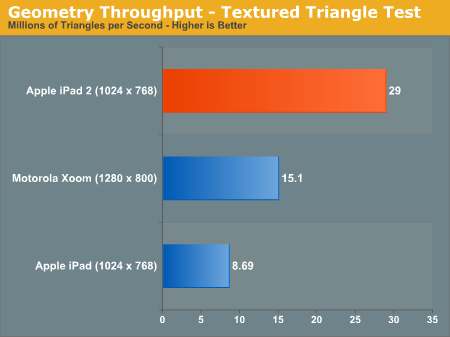
The original iPad could manage 8.7 million triangles per second in this test. The iPad 2? 29 million. An increase of over 3x. Developers with existing titles on the iPad could conceivably triple geometry complexity with no impact on performance on the iPad 2.
Now for the more complex case - a fragment lit triangle test:
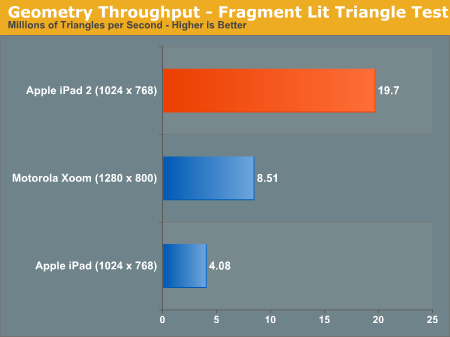
The performance gap widens. While the PowerVR SGX 535 in the A4 could barely break 4 million triangles per second in this test, the PowerVR SGX 543MP2 in the A5 manages just under 20 million. There's just no competition here.
I mentioned an improvement in texturing performance earlier. The GLBenchmark texture fetch test puts numbers to that statement:
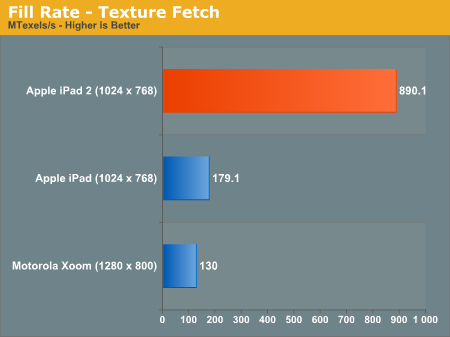
We're talking about nearly a 5x increase in texture fetch performance. This has to be due to more than an increase in the amount of texturing hardware. An improvement in throughput? Increase in memory bandwidth? It's tough to say without knowing more at this point.
| Apple iPad vs. iPad 2 | ||||
| Apple iPad (PowerVR SGX 535) | Apple iPad 2 (PowerVR SGX 543MP2) | |||
| Array test - uniform array access |
3412.4 kVertex/s
|
3864.0 kVertex/s
|
||
| Branching test - balanced |
2002.2 kShaders/s
|
11412.4 kShaders/s
|
||
| Branching test - fragment weighted |
5784.3 kFragments/s
|
22402.6kFragments/s
|
||
| Branching test - vertex weighted |
3905.9 kVertex/s
|
3870.6 kVertex/s
|
||
| Common test - balanced |
1025.3 kShaders/s
|
4092.5 kShaders/s
|
||
| Common test - fragment weighted |
1603.7 kFragments/s
|
3708.2 kFragments/s
|
||
| Common test - vertex weighted |
1516.6 kVertex/s
|
3714.0 kVertex/s
|
||
| Geometric test - balanced |
1276.2 kShaders/s
|
6238.4 kShaders/s
|
||
| Geometric test - fragment weighted |
2000.6 kFragments/s
|
6382.0 kFragments/s
|
||
| Geometric test - vertex weighted |
1921.5 kVertex/s
|
3780.9 kVertex/s
|
||
| Exponential test - balanced |
2013.2 kShaders/s
|
11758.0 kShaders/s
|
||
| Exponential test - fragment weighted |
3632.3 kFragments/s
|
11151.8 kFragments/s
|
||
| Exponential test - vertex weighted |
3118.1 kVertex/s
|
3634.1 kVertex/s
|
||
| Fill test - texture fetch |
179116.2 kTexels/s
|
890077.6 kTexels/s
|
||
| For loop test - balanced |
1295.1 kShaders/s
|
3719.1 kShaders/s
|
||
| For loop test - fragment weighted |
1777.3 kFragments/s
|
6182.8 kFragments/s
|
||
| For loop test - vertex weighted |
1418.3 kVertex/s
|
3813.5 kVertex/s
|
||
| Triangle test - textured |
8691.5 kTriangles/s
|
29019.9 kTriangles/s
|
||
| Triangle test - textured, fragment lit |
4084.9 kTriangles/s
|
19695.8 kTriangles/s
|
||
| Triangle test - textured, vertex lit |
6912.4 kTriangles/s
|
20907.1 kTriangles/s
|
||
| Triangle test - white |
9621.7 kTriangles/s
|
29771.1 kTriangles/s
|
||
| Trigonometric test - balanced |
1292.6 kShaders/s
|
3249.9 kShaders/s
|
||
| Trigonometric test - fragment weighted |
1103.9 kFragments/s
|
3502.5 kFragments/s
|
||
| Trigonometric test - vertex weighted |
1018.8 kVertex/s
|
3091.7 kVertex/s
|
||
| Swapbuffer Speed |
600
|
599
|
||
Enough with the synthetics - how much of an improvement does all of this yield in the actual GLBenchmark 2.0 game tests? Oh it's big.
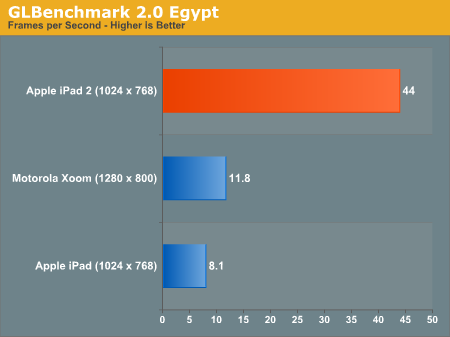
Without AA, the Egypt test runs at 5.4x the frame rate of the original iPad. It's even 3.7x the speed of the Tegra 2 in the Xoom running at 1280 x 800 (granted that's an iOS vs. Android comparison as well).
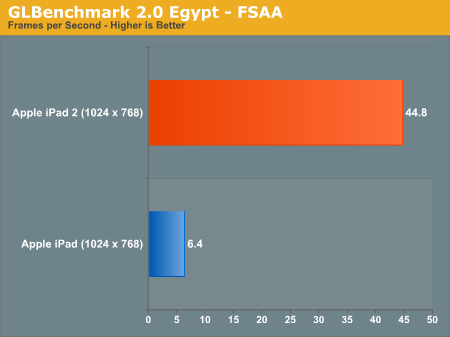
With AA enabled the iPad 2 advantage grows to 7x. In a game with the complexity of the Egypt test the original iPad wouldn't be remotely playable while the iPad 2 could run it smoothly.
The Pro test is a little more reasonable, showing a 3 - 4x increase in performance compared to the original iPad:
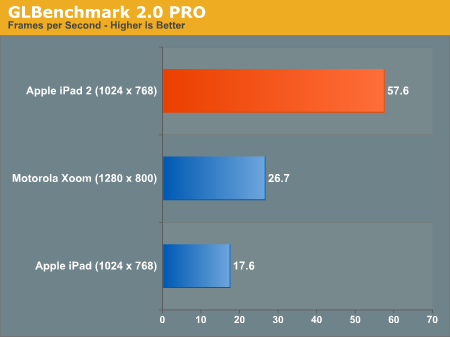
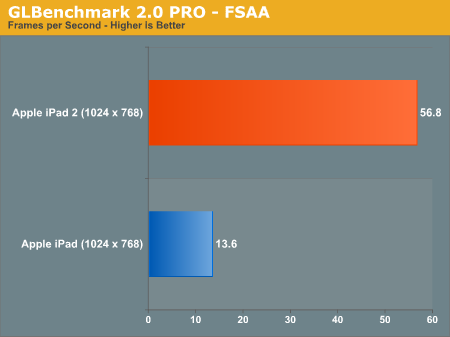
While we weren't able to reach the 9x figure claimed by Apple (I'm not sure that you'll ever see 9x running real game code), a range of 3 - 7x in GLBenchmark 2.0 is more reasonable. In practice I'd expect something less than 5x but that's nothing to complain about.











189 Comments
View All Comments
FrederickL - Saturday, March 19, 2011 - link
I have to say that I largely agree even though I perhaps would not use PrinceGaz' somewhat "undiplomatic" description of the iPad's current customer profile! However, I am obliged to agree that tablets of this size are of little interest (IMO) until they are functional enough that they can _replace_ ones laptop. The case for buying an iPad (fine piece of content consumption kit as it is) falls down at that first fence as far as I am concerned. In general terms my mobile device needs are met by my Desire Z. A third or fourth generation10 - 11 inch tab with a full slide out qwerty (either Honeycomb or Win 8 ARM, the iOS is not to my taste) with more connection/plug options than you can shake stick at, with a docking station+large screen at home - now THAT would open my wallet!
dhuhtala - Sunday, March 20, 2011 - link
I tend to agree - I've always carried a Blackberry phone instead of an iPhone just because it has a slide-out keyboard...I will not compromise on that! This makes the device really practical and I use it a lot.That's why I'm closely watching the ASUS eee Slider - a tablet with a slide out keyboard - that sounds like it will be much cheaper than the Xoom (rumour has it at $500.
The Tegra 2 probably won't meet my requirements for playing MKV video files though, from what I've gathered...
http://www.reghardware.com/2011/03/15/preview_tabl...
solipsism - Sunday, March 20, 2011 - link
You’re the minority. The majority of buyers just want something that works, which is why the techtarded people of the world are jumping into simpler devices for email and browsing, not building their own PCs and running a home-brew version of Linux.synaesthetic - Sunday, March 20, 2011 - link
A netbook can check email and browse the internet for significantly less money. Most people I know, even the techtarded as you so colorfully put it, realize this and do not buy an iPad.The people I know who buy iPads are college students who get Mommy and Daddy to pay for it, and hipsters.
doobydoo - Sunday, March 20, 2011 - link
I couldn't disagree more.I would say that technically savvy people are the ones who are MORE likely to buy an iPad.
I say this as a technically savvy person who has not yet bought an iPad, but can see the appeal:
Firstly - the iPad is lighter, thinner, and has better battery life than most netbooks.
Secondly - it's more capable, in that u wont have to wait around for Windows or whatever OS you're using to load, the apps are designed for the platform and the device's capabilities so it's actually quicker. Games, for example, are much nicer to play and to control on an iPad when compared to a netbook.
Thirdly - it's more convenient in certain situations - u dont need to find a table to set it on or put it on ur lap - you can just hold it, such as when standing up or walking along, or where ur sitting at a table with food all over it.
Fourthly - it's touch screen, extremely advantageous in certain situations. For example, the iPad makes a much better presentation device than any netbook can.
It's such blind ignorance of a lot of people on here to assume that it's non-techy people who buy iPads. It's the non-haters, who buy iPads. The people who want to embrace the latest technology and actually see what it's about before dismissing it with some pathetic stereotype.
medi01 - Tuesday, March 22, 2011 - link
It's a "for fun" device, so if you buy it for some thing else, I doubt your "tech savyiness".And for some, not being able to read stuff you've written to your own device, is a show-stopper. Calling this "hate" is silly.
synaesthetic - Sunday, March 20, 2011 - link
It pretty much is a toy, but I really think smartphones are better toys. They're smaller, and you carry your phone anyway, so why not game on it to kill some time between appointments?Rick83 - Saturday, March 19, 2011 - link
I still stick to my 5" tablet (though something slightly larger might work also...but 7" is already too much).That I can carry around all day (when I want to, and keep a separate non-smart phone that does telephone well enough) and yet it is much more useful than the 4" and 3.5" smart phones. I can comfortably hold it with one hand, buttons are nice and big in landscape mode, the dock gives me USB host, there's BT for keyboards as well, dock with hdmi-out, analog video-out...basically it does anything I would ever need, in the ideal portable form factor.
It could do with a marginally better touch screen and build quality, and performance and stability aren't that great, but considering it predated the first iPad by about 6 months, I'm willing to accept the odd quirk. Also, it still works after quite some use over the last 18 months, with no visible battery life issues.
I hope that the mini-tablet form factor will be explored some more in the future, I would be willing to replace my current device with something similar once the warranty has expired...
Oh did I mention that it cost me less than a third of an iPad? (But, no, no flash either ;))
tzhu07 - Saturday, March 19, 2011 - link
I've been trying to figure out a use for the iPad, and the only thing I can think of is that it's good for doing really simple things and taking notes. Also, when you take it out in front of a client during a lunch meeting, it tends to impress them.But, yeah, I find that there isn't really a need for a device that bridges the gap between a laptop and a smartphone....yet.
vision33r - Saturday, March 19, 2011 - link
It's all about the Apps, regardless which OS they are useless without apps.The iPad has tons of productivity and enterprise ready apps. Would like to see an iMovie clone on Android or some quality productivity apps. So far only iOS has the most real apps.